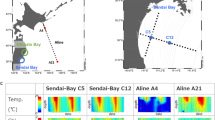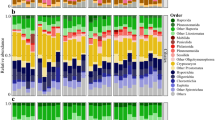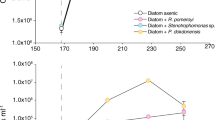Abstract
The potential of metatranscriptomic sequencing to provide insights into the environmental factors that regulate microbial activities depends on how fully the sequence libraries capture community expression (that is, sample-sequencing depth and coverage depth), and the sensitivity with which expression differences between communities can be detected (that is, statistical power for hypothesis testing). In this study, we use an internal standard approach to make absolute (per liter) estimates of transcript numbers, a significant advantage over proportional estimates that can be biased by expression changes in unrelated genes. Coastal waters of the southeastern United States contain 1 × 1012 bacterioplankton mRNA molecules per liter of seawater (∼200 mRNA molecules per bacterial cell). Even for the large bacterioplankton libraries obtained in this study (∼500 000 possible protein-encoding sequences in each of two libraries after discarding rRNAs and small RNAs from >1 million 454 FLX pyrosequencing reads), sample-sequencing depth was only 0.00001%. Expression levels of 82 genes diagnostic for transformations in the marine nitrogen, phosphorus and sulfur cycles ranged from below detection (<1 × 106 transcripts per liter) for 36 genes (for example, phosphonate metabolism gene phnH, dissimilatory nitrate reductase subunit napA) to >2.7 × 109 transcripts per liter (ammonia transporter amt and ammonia monooxygenase subunit amoC). Half of the categories for which expression was detected, however, had too few copy numbers for robust statistical resolution, as would be required for comparative (experimental or time-series) expression studies. By representing whole community gene abundance and expression in absolute units (per volume or mass of environment), ‘omics’ data can be better leveraged to improve understanding of microbially mediated processes in the ocean.
Similar content being viewed by others
Log in or create a free account to read this content
Gain free access to this article, as well as selected content from this journal and more on nature.com
or
References
Azam F, Hodson RE . (1977). Size distribution and activity of marine microheterotrophs. Limnol Oceanogr 22: 492–501.
Bürgmann H, Howard EC, Ye WY, Sun F, Sun SL, Napierala S et al. (2007). Transcriptional response of Silicibacter pomeroyi DSS-3 to dimethylsulfoniopropionate (DMSP). Environ Microbiol 9: 2742–2755.
Campbell BJ, Waidner LA, Cottrell MT, Kirchman DL . (2008). Abundant proteorhodopsin genes in the North Atlantic Ocean. Environ Microbiol 10: 99–109.
Cho J-C, Giovannoni SJ . (2004). Cultivation and growth characteristics of a diverse group of oligotrophic marine gammaproteobacteria. Appl Environ Microbiol 70: 432–440.
Church MJ, Wai B, Karl DM, DeLong EF . (2010). Abundances of crenarchaeal amoA genes and transcripts in the Pacific Ocean. Environ Microbiol 12: 679–688.
Coyne KJ, Handy SM, Demir E, Whereat EB, Hutchins DA, Portune KJ et al. (2005). Improved quantitative real-time PCR assays for enumeration of harmful algal species in field samples using an exogenous DNA reference standard. Limnol Oceanogr Meth 3: 381–391.
Dinsdale EA, Edwards RA, Hall D, Angly F, Breitbart M, Brulc JM et al. (2008). Functional metagenomic profiling of nine biomes. Nature 452: 629–632.
Ducklow HW . (2000). Bacterial production and biomass in the oceans. In: Kirchman (ed). Microbial Ecology of the Ocean, 1st edn. Wiley-Liss: New York, NY.
Frias-Lopez J, Shi Y, Tyson GW, Coleman ML, Schuster SC, Chisholm SW et al. (2008). Microbial community gene expression in ocean surface waters. Proc Natl Acad Sci 105: 3805–3810.
Gilbert JA, Field D, Huang Y, Edwards R, Li W, Gilna P et al. (2008). Detection of large numbers of novel sequences in the metatranscriptomes of complex marine microbial communities. PLoS ONE 3: e3042.
Gomez-Alvarez V, Teal TK, Schmidt TM . (2009). Systematic artifacts in metagenomes from complex microbial communities. ISME J 3: 1314–1317.
Hannah MA, Redestig H, Leisse A, Willmitzer L . (2008). Global mRNA changes in microarray experiments. Nat Biotechnol 26: 741–742.
Hewson I, Poretsky RS, Beinart RA, White AE, Shi T, Bench SR et al. (2009a). In situ transcriptomic analysis of the globally important keystone N2-fixing taxon Crocosphaera watsonii. ISME J 3: 618–631.
Hewson I, Poretsky RS, Dyhrman ST, Zielinski B, White AE, Tripp HJ et al. (2009b). Microbial community gene expression within colonies of the diazotroph, Trichodesmium, from the Southwest Pacific Ocean. ISME J 3: 1286–1300.
Hollibaugh JT, Gifford SM, Sharma S, Bano N, Moran MA . (2010). Metatranscriptomic analysis of ammonia-oxidizing organisms in an estuarine bacterioplankton assemblage. ISME J. In press.
Kiene RP, Capone DG . (1988). Microbial transformations of methylated sulfur-compounds in anoxic salt-marsh sediments. Microb Ecol 15: 275–291.
Margulies M, Egholm M, Altman WE, Attiya S, Bader JS, Bemben LA et al. (2005). Genome sequencing in microfabricated high-density picolitre reactors. Nature 437: 376–380.
Neidhardt FC, Umbarger HE . (1996). Chemical composition of Escherichia coli. In: Böck A, Curtiss III R, Kaper JB, Karp PD, Neidhardt FC, Nyström T et al (eds). EcoSal—Escherichia coli and Salmonella: Cellular and Molecular Biology, 2nd edn. ASM Press: Washington, DC.
Pages H, Aboyoun P, Gentleman R, DebRoy S . (2009). Biostrings: string objects representing biological sequences, and matching algorithms. R package version 2.14.8.
Pakulski JD, Kiene RP . (1992). Foliar release of dimethylsulfoniopropionate from Spartina alterniflora. Mar Ecol-Prog Ser 81: 277–287.
Passalacqua KD, Varadarajan A, Ondov BD, Okou DT, Zwick ME, Bergman NH . (2009). Structure and complexity of a bacterial transcriptome. J Bacteriol 191: 3203–3211.
Pomeroy LR, Sheldon JE, Sheldon WM, Blanton JO, Amft J, Peters F . (2000). Seasonal changes in microbial processes in estuarine and continental shelf waters of the south-eastern USA. Estuar Coast Shelf S 51: 415–428.
Poretsky RS, Bano N, Buchan A, LeCleir G, Kleikemper J, Pickering M et al. (2005). Analysis of microbial gene transcripts in environmental samples. Appl Environ Microbiol 71: 4121–4126.
Poretsky RS, Gifford SM, Rinta-Kanto J, Vila-Costa M, Moran MA . (2009a). Analyzing gene expression from marine microbial communities using environmental transcriptomics. JoVE 2. (http://www.jove.com/index/details.stp?ID=1086).
Poretsky RS, Hewson I, Sun SL, Allen AE, Zehr JP, Moran MA . (2009b). Comparative day/night metatranscriptomic analysis of microbial communities in the North Pacific subtropical gyre. Environ Microbiol 11: 1358–1375.
Poretsky RS, Sun S, Mou X, Moran MA . (2010). Transporter genes expressed by coastal bacterioplankton in response to dissolved organic carbon. Environ Microbiol 12: 616–627.
R Development Core Team (2009). R: A Language and Environment for Statistical Computing v210.0. R Foundation for Statistical Computing: Vienna, Austria, (http://www.R-project.org).
Robinson M, Oshlack A . (2010). A scaling normalization method for differential expression analysis of RNA-seq data. Genome Biol 11: R25.
Rodriguez-Brito B, Rohwer F, Edwards RA . (2006). An application of statistics to comparative metagenomics. BMC Bioinformatics 7: 162.
Rusch DB, Halpern AL, Sutton G, Heidelberg KB, Williamson S, Yooseph S et al. (2007). The Sorcerer II Global Ocean Sampling expedition: northwest atlantic through eastern tropical pacific. PLoS Biol 5: 398–431.
Shi YM, Tyson GW, DeLong EF . (2009). Metatranscriptomics reveals unique microbial small RNAs in the ocean's water column. Nature 459: 266–269.
Simon M, Azam F . (1989). Protein-content and protein-synthesis rates of planktonic marine bacteria. Mar Ecol Prog Ser 51: 201–213.
Stewart FJ, Ottesen EA, DeLong EF . (2010). Development and quantitative analyses of a universal rRNA-subtraction protocol for microbial metatranscriptomics. ISME J 4: 896–907.
Strimmer K . (2008). A unified approach to false discovery rate estimation. BMC Bioinformatics 9: 303.
Tatusov R, Fedorova N, Jackson J, Jacobs A, Kiryutin B, Koonin E et al. (2003). The COG database: an updated version includes eukaryotes. BMC Bioinformatics 4: 41.
Urich TA, Lanzen J, Qi DH, Huson DH, Schleper C, Schuster SC . (2008). Simultaneous assessment of soil microbial community structure and function through analysis of the meta-transcriptome. PLoS ONE 3: e2527.
van de Peppel J, Kemmeren P, van Bakel H, Radonjic M, van Leenen D, Holstege FCP . (2003). Monitoring global messenger RNA changes in externally controlled microarray experiments. EMBO Rep 4: 387–393.
Varaljay VA, Howard EC, Sun SL, Moran MA . (2010). Deep sequencing of a dimethylsulfoniopropionate-degrading gene (dmdA) by using PCR primer pairs designed on the basis of marine metagenomic data. Appl Environ Microbiol 76: 609–617.
White JR, Nagarajan N, Pop M . (2009). Statistical methods for detecting differentially abundant features in clinical metagenomic samples. PLoS Comput Biol 5: e1000352.
Xu L, Chen H, Hu XH, Zhang RM, Zhang Z, Luo ZW . (2006). Average gene length is highly conserved in prokaryotes and eukaryotes and diverges only between the two kingdoms. Mol Biol Evol 23: 1107–1108.
Acknowledgements
We thank R Newton for assistance with sample collection and bioinformatics analysis, L Tomsho and S Schuster at Penn State University for 454 sequencing expertise, JT Hollibaugh for comments and discussion on the article and S Rathbun for helpful discussions on statistical methods. Nutrient data were provided by K Hunter and S Joye through the Georgia Coastal Ecosystems Long Term Ecological Research program (OCE-0620959). This project was supported by funding from the Gordon and Betty Moore Foundation and the National Science Foundation Microbial Observatories Program (MCB-0702125).
Author information
Authors and Affiliations
Corresponding author
Additional information
Supplementary Information accompanies the paper on The ISME Journal website
Supplementary information
Rights and permissions
About this article
Cite this article
Gifford, S., Sharma, S., Rinta-Kanto, J. et al. Quantitative analysis of a deeply sequenced marine microbial metatranscriptome. ISME J 5, 461–472 (2011). https://doi.org/10.1038/ismej.2010.141
Received:
Revised:
Accepted:
Published:
Issue date:
DOI: https://doi.org/10.1038/ismej.2010.141
Keywords
This article is cited by
-
Soil microbial ecology through the lens of metatranscriptomics
Soil Ecology Letters (2024)
-
Aerobic bacteria produce nitric oxide via denitrification and promote algal population collapse
The ISME Journal (2023)
-
Synechococcus nitrogen gene loss in iron-limited ocean regions
ISME Communications (2023)
-
Linking transcriptional dynamics of CH4-cycling grassland soil microbiomes to seasonal gas fluxes
The ISME Journal (2022)
-
The ecological responses of bacterioplankton during a Phaeocystis globosa bloom in Beibu Gulf, China highlighted by integrated metagenomics and metatranscriptomics
Marine Biology (2022)



